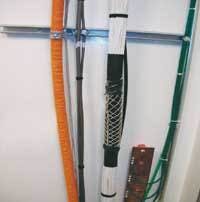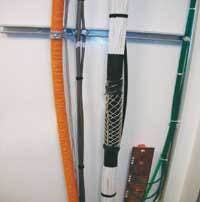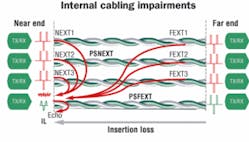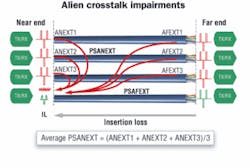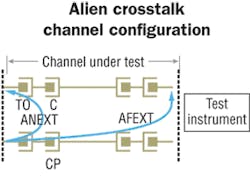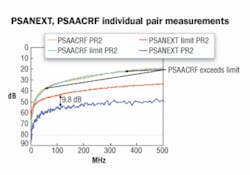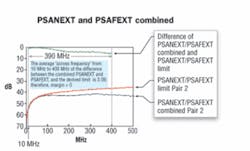Document provides guidelines for 10GBase-T operation on installed cabling systems.
In March 2003, the 802.3 working group of the IEEE LAN/MAN Standards Committee requested the assistance of TIA TR-42 to help investigate the feasibility of 10-Gigabit Ethernet operation on 4-pair 100-Ω horizontal copper cabling, and to assist the IEEE group in the study of the impact of alien crosstalk impairments. In response, TIA initiated two projects.
Project PN-3-0134 was initiated to investigate the installed balanced cabling performance for 10GBase-T applications, including the mitigation of cabling impairments and field testing. This effort resulted in the development of ANSI/TIA/EIA-TSB-155, Guidelines for the Assessment and Mitigation of Installed Category 6 Cabling To Support 10GBase-T; expected publication of this document is this month.
Project SP-3-4426-AD10 was initiated to develop cabling and component specifications and test procedures to support the operation of 10GBase-T over 100 meters of structured balanced twisted-pair copper cabling. This effort resulted in the development of ANSI/TIA/EIA-568-B.2-10, Transmission Performance Specifications for 4-Pair 100-Ω Augmented Category 6 Cabling; expected publication for this document is sometime this year. This specification includes accuracy requirements for Level IIIe field testers.
The 802.3 working group has completed the development of 10GBase-T. On June 8, 2006, the IEEE-SA standards board approved the standard for 10GBase-T to be published as IEEE Std. 802.3an-2006.
What’s different?
From a historical perspective, TSB-155 is the fourth in a series of TIA/EIA documents addressing field testing of twisted-pair cabling. Although the purpose and scope of each of these documents are different, collectively they represent the incremental advances in field testing of twisted-pair cabling over the last 10 years.
Given that the basis for many aspects of TSB-155 is founded in the prior TIA/EIA field-test documents, here is a brief summary to aid in the understanding of TSB-155 and to assist in pointing out the similarities and differences among this series of specifications:
TSB-67 and TSB-95 have been incorporated into TIA/EIA-568-B.1 Commercial Building Telecommunications Cabling Standard Part 1: General Requirements and TIA/EIA-568-B.2 Commercial Building Telecommunications Cabling Standard Part 2: 100-Ω Balanced Twisted Pair Cabling Components.
• TSB-67 Transmission Performance Specifications for Field Testing of Unshielded Twisted-Pair Cabling Systems, published in 1995, provided the first detailed specifications for the post-installation performance of installed cabling and field-tester requirements, including detailed procedures for verifying field-tester accuracy levels against levels of performance (e.g., Level I and Level II). Additionally, TSB-67 introduced the basic link and channel test configurations and established the test parameters of wiremap, length, attenuation, and near-end crosstalk.
• TSB-95 Additional Transmission Performance Guidelines for 4-Pair 100-Ω Category 5 Cabling, published in 1999, provided guidelines to further characterize Category 5 cabling systems to ensure the operation of 1000Base-T Gigabit Ethernet over the installed base of Category 5 cabling systems. TSB-95 defined the additional cabling parameters of return loss, equal-level far-end crosstalk (ELFEXT), propagation delay, and delay skew, as well as field test procedures and corrective actions. In addition, TSB-95 included accuracy recommendations for enhanced Level II (Level II-E) field testers.
• TIA/EIA-568-B.2-1 Transmission Performance Specifications for 4-Pair 100-Ω Category 6 Cabling, published in 2002, provided the accuracy requirements for Level III field testers.
Above-and-beyond recommendations
Recognizing that 10GBase-T is dependent on cabling performance characterized to higher frequencies than specified for Category 6 and alien crosstalk performance of the cabling, TSB-155 provides the recommendations to deploy 10GBase-T over installed 100-Ω, 4-pair Category 6 cabling, including the following:
